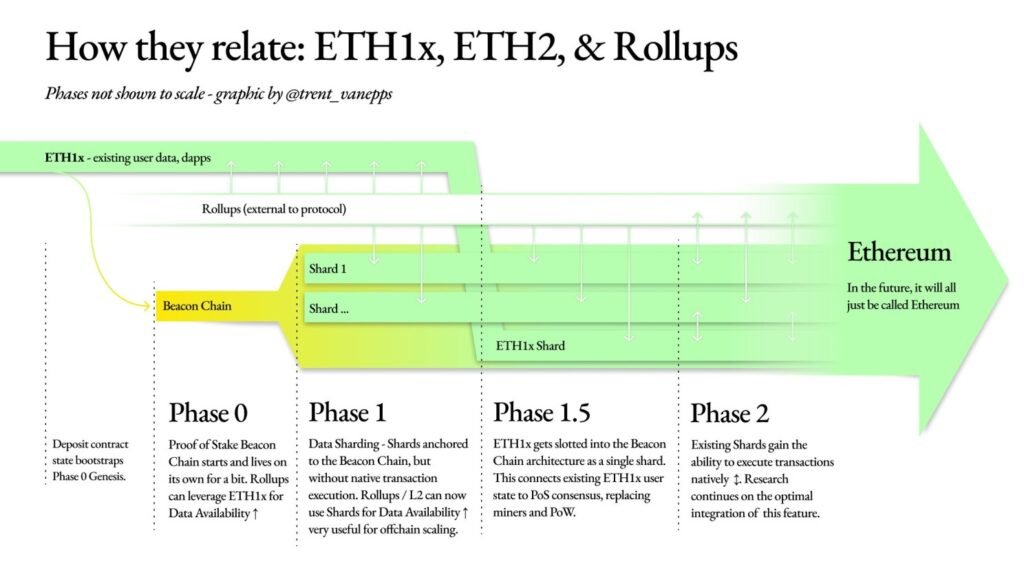Ethereum 2.0 Updates: A Comprehensive Guide to the Future of Ethereum
Ethereum, the second-largest cryptocurrency by market capitalization, is undergoing a significant transformation with the rollout of Ethereum 2.0 updates. These updates aim to address the scalability, security, and sustainability issues of the current Ethereum network. This comprehensive guide will delve into the latest Ethereum 2.0 updates, what they mean for the future of Ethereum, and how they will impact users and developers alike.
What is Ethereum 2.0?
Ethereum 2.0, also known as Eth2 or Serenity, is an upgrade to the existing Ethereum blockchain.
The main goal of Ethereum 2.0 updates is to improve the network’s efficiency and scalability, allowing it to handle more transactions per second while reducing energy consumption. This upgrade introduces several key changes, including the shift from Proof of Work (PoW) to Proof of Stake (PoS), the implementation of shard chains, and various other enhancements.
Key Components of Ethereum 2.0 Updates
Proof of Stake (PoS)
One of the most significant Ethereum 2.0 updates is the transition from Proof of Work (PoW) to Proof of Stake (PoS). In PoW, miners compete to solve complex mathematical puzzles to validate transactions and add them to the blockchain. This process requires substantial computational power and energy. PoS, on the other hand, allows validators to create new blocks and confirm transactions based on the number of coins they hold and are willing to “stake” as collateral.
Benefits of PoS:
- Energy Efficiency: PoS significantly reduces energy consumption compared to PoW.
- Increased Security: PoS is believed to be more secure against certain types of attacks, such as 51% attacks.
- Decentralization: PoS encourages a more decentralized network by lowering the barrier to entry for validators.
Beacon Chain
The Beacon Chain is a central component of Ethereum 2.0 updates. It acts as the coordination layer for the new PoS network, managing validators and their stakes, and ensuring that shard chains remain synchronized.
Functions of the Beacon Chain:
- Validator Management: The Beacon Chain handles the registration and management of validators.
- Randomness: It provides a source of randomness for selecting validators to propose and attest to blocks.
- Crosslinking: The Beacon Chain ensures communication between shard chains, maintaining network integrity.
Shard Chains
Shard chains are another critical aspect of Ethereum 2.0 updates. Sharding involves splitting the Ethereum network into smaller, more manageable pieces called shards. Each shard operates as a separate chain, processing its transactions and smart contracts.
Advantages of Shard Chains:
- Scalability: Sharding increases the network’s capacity to handle more transactions simultaneously.
- Parallel Processing: Multiple shard chains can process transactions in parallel, improving overall efficiency.
- Load Distribution: Sharding distributes the network load, reducing congestion and lowering transaction fees.
The Phases of Ethereum 2.0 Updates
Ethereum 2.0 updates are being implemented in multiple phases to ensure a smooth transition and minimize disruptions. Here’s a breakdown of the key phases:

Phase 0: Beacon Chain Launch
Phase 0, launched in December 2020, marked the introduction of the Beacon Chain. This phase focused on establishing the PoS mechanism and laying the groundwork for future updates. The Beacon Chain operates independently of the existing Ethereum mainnet but will eventually coordinate with it.
Phase 1: Shard Chains
Phase 1, expected to be rolled out in 2023-2024, will introduce shard chains. This phase aims to enhance the network’s scalability by enabling parallel transaction processing. Initially, shard chains will not support smart contracts but will focus on improving data availability.
Phase 1.5: The Merge
The Merge, or Phase 1.5, is a crucial step in Ethereum 2.0 updates. It involves merging the existing Ethereum mainnet with the Beacon Chain, transitioning the entire network to PoS. This phase is anticipated to occur in 2024 and will significantly reduce Ethereum’s energy consumption.
Phase 2: Full Implementation
Phase 2 will bring full functionality to shard chains, including support for smart contracts. This phase will complete the Ethereum 2.0 updates, making the network more scalable, secure, and sustainable. The exact timeline for Phase 2 is yet to be determined.
Ethereum 2.0 Updates: Impact on Users and Developers
For Users
The Ethereum 2.0 updates will bring several benefits to users, including:
- Lower Transaction Fees: Improved scalability will reduce network congestion, leading to lower transaction fees.
- Faster Transactions: With shard chains enabling parallel processing, transaction times will decrease.
- Environmental Benefits: The transition to PoS will significantly reduce the network’s carbon footprint.
For Developers
Developers will also benefit from Ethereum 2.0 updates:
- Enhanced Scalability: Shard chains will allow developers to build more complex and resource-intensive applications without worrying about network congestion.
- Improved Security: The PoS mechanism will provide a more secure environment for developing decentralized applications (dApps).
- New Opportunities: Ethereum 2.0’s advancements will open up new possibilities for innovation in the blockchain space.
Challenges and Considerations
While Ethereum 2.0 updates promise numerous advantages, they also come with challenges and considerations:
- Complexity: The transition to Ethereum 2.0 is highly complex, requiring careful coordination and implementation.
- Adoption: Ensuring widespread adoption of the new PoS mechanism and shard chains is crucial for the success of Ethereum 2.0 updates.
- Security: Although PoS offers improved security, it also introduces new attack vectors that need to be addressed.
Ethereum 2.0 Updates: Frequently Asked Questions
What is the current status of Ethereum 2.0 updates?
As of mid-2024, Ethereum 2.0 is in the process of transitioning from Phase 0 to Phase 1.5, with the Beacon Chain live and the merge with the mainnet expected soon.
How can I become a validator in Ethereum 2.0?
To become a validator, you need to stake a minimum of 32 ETH and run validator software. Validators are responsible for proposing and attesting to blocks, helping to secure the network.
Will Ethereum 2.0 replace Ethereum 1.0?
Ethereum 2.0 will not replace Ethereum 1.0 but rather upgrade it. The existing Ethereum mainnet will eventually merge with the Beacon Chain, transitioning to PoS.
Conclusion
Ethereum 2.0 updates represent a monumental shift in the world of blockchain and cryptocurrency. By addressing scalability, security, and sustainability issues, Ethereum 2.0 aims to solidify its position as a leading platform for decentralized applications and smart contracts. As the updates continue to roll out, both users and developers can look forward to a more efficient and robust Ethereum network. Stay tuned for the latest Ethereum 2.0 updates as this exciting journey unfolds.




